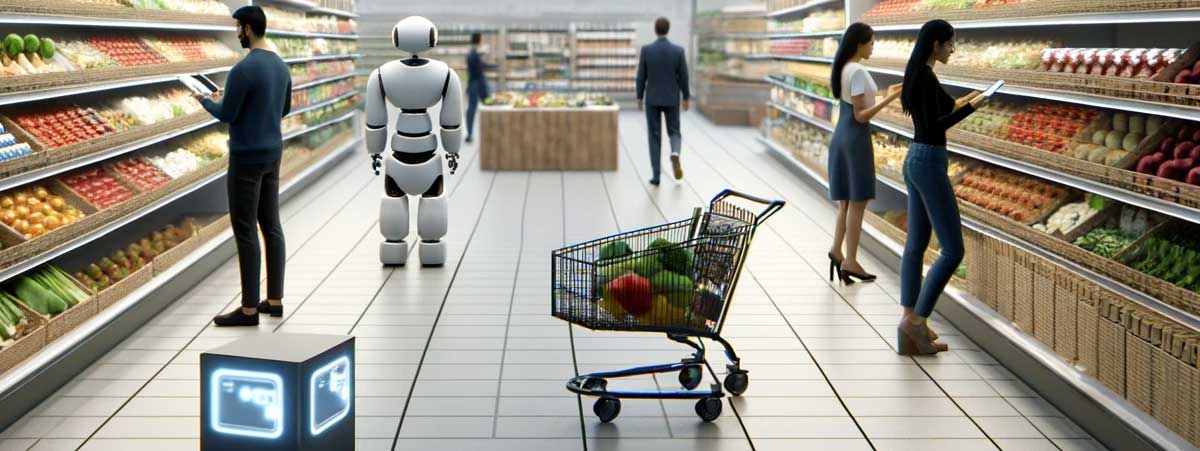The food retail industry is undergoing an unprecedented technological revolution. Supermarkets and food retailers across the globe are rapidly embracing innovative technologies, fundamentally transforming their operations, supply chains, and customer engagement strategies. This article explores five key technologies that are at the forefront of this revolution, each accompanied by real-world examples to illustrate their impact.
1. Blockchain: Ensuring Traceability and Transparency
Blockchain technology is revolutionizing the way food retailers manage their supply chains. By creating transparent, immutable digital records, blockchain enables end-to-end traceability. This not only helps retailers ensure quality control but also allows them to provide customers with critical insights into the sustainability and origins of products.
Example: Walmart, in collaboration with IBM, has implemented blockchain to trace the journey of food products. This initiative enables Walmart to track the origin of over 25 products from 5 different suppliers using blockchain technology, significantly reducing the time required to trace the origin of food items.
2. Artificial Intelligence: Predictive Analytics and Demand Forecasting
Artificial intelligence (AI) is another transformative technology in food retailing. AI analytics help retailers accurately predict demand, optimize inventory, reduce waste, and manage staffing levels through data-based insights.
Example: Kroger, a leading supermarket chain, utilizes AI and machine learning to analyze customer data and predict shopping trends. This allows them to stock products more effectively, reduce waste, and tailor promotions to customer preferences.
3. Automation: Enhancing Productivity and Efficiency
Automation, through the use of robots and software, is automating repetitive workflows, particularly in warehouses and back-office operations. This not only boosts productivity but also improves efficiency and accuracy.
Example: Ocado, a British online supermarket, operates highly automated warehouses. They use a swarm of robots controlled by a sophisticated air traffic control system to fetch groceries, dramatically increasing the speed and efficiency of order fulfillment.
4. Digital Shelves: Dynamic Pricing and Enhanced Information Display
Electronic shelf labels and digital shelves are transforming the in-store experience. These digital solutions allow for dynamic, real-time price changes and provide shoppers with detailed product information, enhancing the shopping experience.
Example: Albert Heijn, a leading supermarket chain in the Netherlands, has implemented electronic shelf labels. These labels not only display prices but also provide product information, allergen alerts, and sustainability credentials, enriching the customer’s shopping journey.
5. Mobile Apps: Personalizing the Shopping Experience
Retailers are increasingly turning to mobile apps to provide a more immersive and personalized shopping experience. These apps offer features like digital coupons, in-store navigation, self-checkout, and personalized recommendations.
Example: The Amazon Go app allows customers to shop in Amazon Go stores without having to go through a traditional checkout process. The app tracks the items customers take from the shelves and automatically charges them when they leave the store, streamlining the shopping experience.
While the adoption of these technologies is still in the early stages, their potential to enhance transparency, boost efficiency, provide valuable insights, improve inventory management, and enrich the customer experience is immense. Food retailers investing in these innovations now are poised to gain long-term competitive advantages as the industry continues to undergo this technology-powered transformation.
The integration of these technologies signifies a paradigm shift in food retailing. Blockchain’s ability to foster trust through transparency, AI’s prowess in predictive analytics, automation’s role in operational efficiency, digital shelves’ contribution to dynamic pricing, and the personalized experience offered by mobile apps collectively mark the dawn of a new era in the food retail sector. As these technologies continue to evolve and synergize, they promise not only to reshape the landscape of food retailing but also to redefine the very nature of how consumers shop for food, making the process more efficient, enjoyable, and sustainable.

